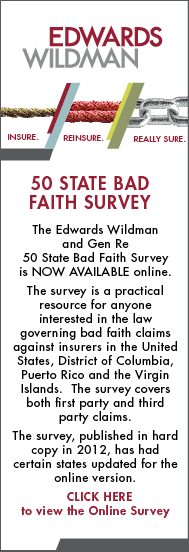 |
|
| edwardswildman.com | |
Be Proactive to Avoid Claims of Institutional Bad Faith by Stephen M. Prignano and Matthew Murphy (Providence) There is a species of bad faith claim that is particularly dangerous – indeed, one might call it a bad faith claim on steroids. What has come to be known as "institutional bad faith" is a claim that attempts to indict the conduct of an entire company, not just that of an individual claims examiner. It is a bad faith claim that may be brought, moreover, on behalf of a group of policyholders or as a class action, rather than on behalf of a single individual. Claims of institutional bad faith may assert a variety of allegations, but they all aspire to a common goal – demonstrating that some pattern or practice so pervades an insurance company that legitimate claims of policyholders are arbitrarily denied. Institutional bad faith claims may allege, for instance, that claims handlers are encouraged to deny claims in order to help the company meet financial goals, or to satisfy certain metrics tracked by the claims department and made known to claims handlers. Bad faith claims of this nature may also allege that claims handlers, while not explicitly instructed to deny claims, are nevertheless encouraged to undertake claims activities that are more likely to result in certain claims outcomes, typically those that deny or significantly limit claims. Plaintiffs’ counsel may seek to support institutional bad faith claims with statistical evidence that claims handlers with a higher incidence of denied claims are graded more favorably than those who deny fewer claims. They may also argue that performance standards used to evaluate claims handlers create the impression that claim outcomes play a role in the evaluation of employees. Discovery in these cases often is particularly aggressive and problematic for the company. Seldom is there sufficient evidence publicly available to support allegations of company-wide bad faith practices. The very nature of the institutional bad faith claim presupposes that insidious practices of the company take place at a high level, behind closed doors and out of public view. Consequently, evidence of institutional practices is frequently developed through the discovery process, where plaintiffs’ counsel seek (and often receive) discovery of company-wide policies and procedures, training and operations manuals, personnel files, compensation practices, departmental notices and directives, high-level management reports and company-wide claims statistics and documents concerning reserving practices. Not only is this discovery far more intrusive and wide-ranging than discovery in the typical bad faith case but, given the nature of the allegations, a court may very well give plaintiffs some latitude to investigate the company’s inner workings. Few cases, therefore, have the ability to expose the claims practices of an insurance company as those alleging institutional bad faith. And, far too often, these claims find at least superficial support in company policies that, while well-intentioned, are ill-conceived or carelessly drafted. Beyond this, of course, the cost of complying with invasive discovery, especially when one considers the massive amount of electronically stored information involved in such a case, will itself create significant pressure on a company to settle these claims – and often for far more than they are really worth. What, then, is a company to do? How can a company effectively protect itself against institutional bad faith claims? While there is no magic bullet or panacea that will insulate a company from exposure to these claims, there are certainly common sense steps that every company can and should take to minimize the risk. Conduct a Critical Audit of Claims Review Guidelines To begin with, companies should ask themselves “what will discovery of our existing policies and procedures reveal to plaintiffs’ counsel, the court and the jury?” and “how would a jury or the court interpret these policies and procedures in light of an allegation of institutional bad faith?” When the wordings of existing policies and procedures are viewed in this light (which may be far different than the context in which they were written), shortcomings in drafting may become readily apparent. Most commonly, words or phrases used in a company's guidelines may be ambiguous. Further, certain words or phrases chosen with a salutary intention may take on a completely different, unintended meaning in the face of allegations of company-wide wrong doing. For instance, guidelines that speak in terms of achieving the “right” or “proper” claim outcome, without defining what “right” or “proper” means in context, leave far too much to the imagination. No doubt the drafter’s intention is to describe an outcome that is “right” or “proper” based on a thoughtful and careful review of the file and consideration of all the information presented by the claim. But in the absence of this explicit explanation, the words “right” or “proper” may mean something far different to a jury considering whether the company engaged in a pattern of denying claims. To reduce the risk of an institutional bad faith claim gaining traction, it is therefore very important that guidelines for the review of claims should be drafted in clear language that does not unwittingly create misimpressions in the minds of claims examiners, or in the minds of third parties (such as juries) who may be unfamiliar with the workings of a claims department. A critical audit of existing guidelines is a good first step to ensure that the company is not, unintentionally, creating evidence that can be used to support a claim of institutional bad faith. Beware of How Statistics Are Tracked and Utilized The claims department is not a profit center, and its internal operations should not be conducted as though it were. The role of a claims handler is to evaluate claims fairly and efficiently, not to meet financial goals. Often, the manner in which a claims department tracks and utilizes statistics becomes the centerpiece of plaintiffs’ efforts to establish a pattern of pre-determined claims outcomes, or to show that claims handlers are encouraged or pressured to achieve certain results. Certainly, claims departments have entirely legitimate reasons for tracking claim denials, approvals or other outcomes. However, there can be little useful purpose served in making department-wide statistics known to individual claims handlers. The publication of such statistics to the very individuals responsible for determining claims outcomes, particularly if done routinely, could easily be interpreted as a means of encouraging claims handlers to improve those statistics in ways that might help the company financially. Claims handlers must be free of influences or pressures, however subtle, to meet financial metrics. This is best achieved if claims handlers are allowed to work in an environment that is free of these influences. To reduce the risk of an institutional bad faith claim, therefore, it is important to consider what information is shared with claims handlers, including information available to them through the company’s computer systems. Does information accessible to claims handlers disclose the financial performance of the claims department in a way that might influence claims decisions? Is it necessary for those individuals to perform their jobs? To minimize the risk of institutional bad faith claims, insurance companies should consider that plaintiffs’ counsel might argue that the claims handlers’ exposure to certain information improperly influences the claims decision. Information that might have this potential, and which is not necessary for the performance of the claims handling function, should not be made available to claims handlers. Do Not Unwittingly Create Incentives For Particular Claims Outcomes While the performance of every claims handler, like all employees, is subject to review, those reviews should not create incentives for claims handlers to reach particular claims outcomes. Unlike virtually any other employee of the company, a claims examiner must exercise free, independent and unbiased judgment that does not necessarily put the financial interests of the company first. Consequently, while certain job performance criteria may be perfectly appropriate for most company employees, those same criteria may be entirely inappropriate in judging the performance of claims handlers. For instance, performance criteria that reward the claims handler for achieving “cost savings” are particularly suspect. Enterprising plaintiffs’ counsel may attempt to spin this into a bad faith practice that encourages claims handlers to take cost-savings shortcuts in the evaluation of claims, leading to incomplete file review and more claim denials. Plaintiffs’ counsel may also argue that the incentive to achieve cost savings directly encourages claims handlers to arbitrarily deny claims. Another problem area concerns the cumulative effect of performance criteria. While no individual criterion may reward or incentivize claims handlers to deny claims, the sum total of the performance criteria may unintentionally have this effect. Plaintiffs’ counsel may argue that the sum of a performance review is greater than its parts, and may use statistical analysis to attempt to show that claims handlers with higher denial rates are reviewed more favorably, compensated more generously, or receive better bonuses. An audit of performance criteria and the employee review process, when undertaken through the lens of a potential institutional bad faith claim, may be very revealing. Certainly, the time to do this is before the company is faced with a class action lawsuit, when the company is in the best position to spot potential problems and make needed corrections. Avoid the Use of Quotas It should be obvious that financial quotas, or claim outcome quotas of any kind, are absolutely improper in evaluating the performance of a claims handler. Somewhat less obvious, however, is that other forms of quotas may influence claims handling. For example, claims departments may require or encourage claims handlers to employ a certain number of claims investigation activities in reviewing a file. Often, this is done for the purpose of ensuring the thoroughness of a file review. Problems develop, however, where a statistical relationship can be shown between a high number of “claims investigation activities” and the denial of claims. Conversely, quotas may present problems where they mandate the number of claims that claims handlers are expected to resolve, or where time limits are placed on a claims handlers’ work. Here again, such quotas may be portrayed as so unrealistic that they only serve one real purpose – to promote a higher incidence of claims denials by discouraging claims handlers from thoroughly evaluating claims. All forms of quotas or targets should be evaluated carefully for reasonableness and for whether the nature of the quota or target encourages shoddy practices to meet goals. Any quota or target that does not, as its primary purpose, encourage the fair, thorough and timely resolution of a claim should be discarded and studiously avoided. Send the Right Message – Encourage Best Practices It is not enough, of course, to avoid practices that might inadvertently create a claims handling structure that lends itself to claims of institutional bad faith. Proactive steps must be taken to create a structure that serves as a barrier to those claims. Written guidelines and company practices should, at a minimum, accomplish the following:
Institutional bad faith claims should not be taken lightly. These are not garden variety bad faith claims, and they have significant potential to damage a company’s reputation, wreak havoc during the litigation process and expose the company to substantial extra-contractual and punitive damages. Unfortunately, many companies have unwittingly made it easier for plaintiffs’ counsel to pursue these claims as a result of careless internal practices and poorly drafted internal documents. Fortunately, these self-inflicted wounds can be identified and remedied before they cause problems. Diligent, proactive examinations of internal policies and procedures, when coupled with proper training of claims handling professionals, will offer the best protection against falling victim to this particularly dangerous liability. Contact
| |
 |
|


